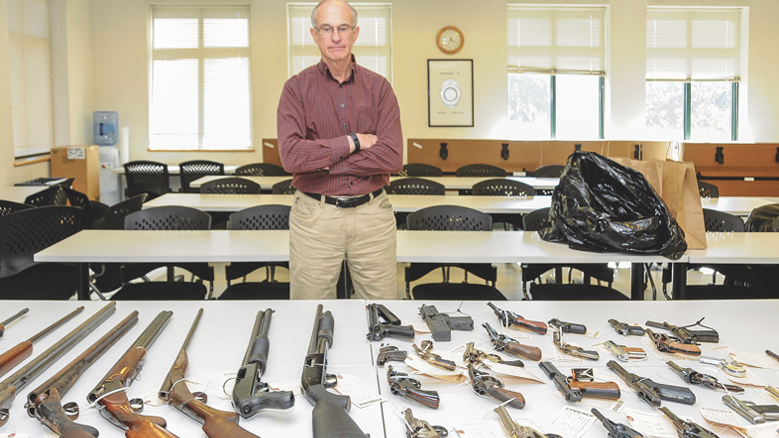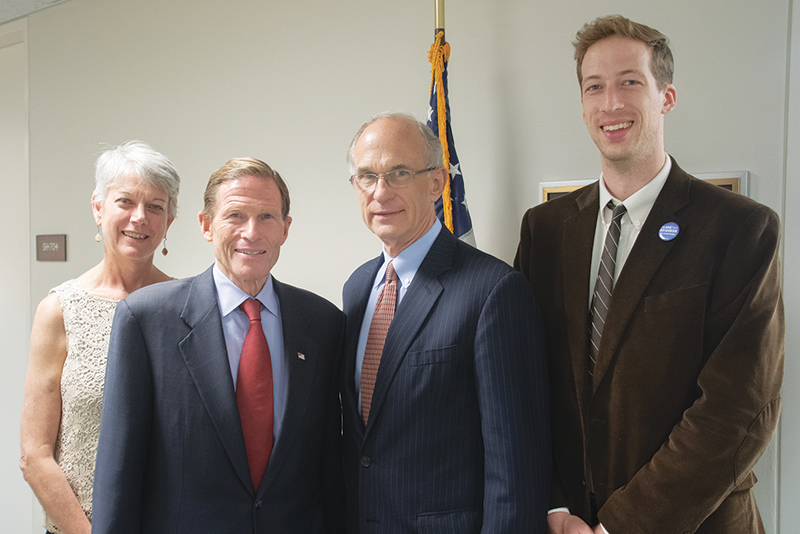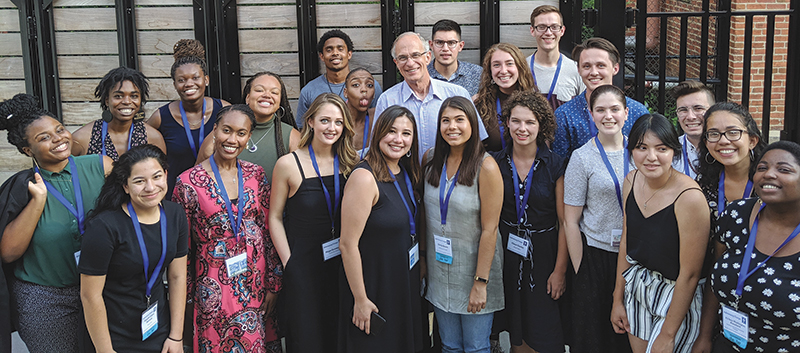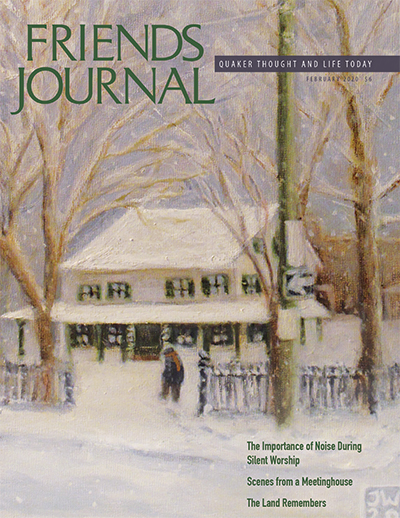
“You think you have a Second Amendment problem? Maybe what you have is a serious Second Commandment problem!” These words were spoken to me in a coffee shop in Sandy Hook, Connecticut, less than a mile away from the former site of Sandy Hook Elementary School in Newtown.
Let me back up and give you some context. My nephew Daniel Barden was murdered in that school in his first-grade classroom. That may be all of the context you need. I had come to talk with pastor Matt Crebbin these six years later as part of the “relentless networking” I am doing to try to understand how I can be a more effective advocate for changes to stop gun violence in our country. As a Quaker for more than 40 years, I find the basics come easy. I try to recognize that of God in everyone, and from this premise, so many traditional Quaker values flow: not using violence in any way, respect for every individual, even those with whom I strongly disagree or whose actions I find contrary to all that is good.
I came to see Crebbin because he is the current head of the Newtown Interfaith Council (and the pastor of the Newtown Congregational Church), and I wanted to understand if these councils were a channel I should pursue in other towns—even nationally—to encourage people to call, vote for, and demand change. What I had totally forgotten was that six years earlier, he had opened up his parish hall as a place for our family and scores of others to grieve and meet and comfort each other after Daniel’s funeral at another church in Newtown. Those days were a blur, but I recall that we never asked for it: they reached out and asked us to accept their loving hospitality. The arrangements had been made, the food was prepared and ready, and his congregants tenderly welcomed us to seek shelter with them for that time. Upon realizing I was meeting the pastor who was so kind to us, I profusely thanked him. I was almost in tears, as usually happens to me when I am faced with recalling the details of those days. Such are the unexpected fruits of relentlessly networking: sometimes you end up just where you started.

So, what is that Second Commandment problem? We are commanded to love God and not graven images or other objects, and not to “bow down to them or serve them.” The problem is that for some people in the United States, guns have replaced God as the source of their trust and as the authority they turn to in order to resolve conflicts. Our cowboy-heritage culture takes pride in having killing power in our control so that we can right wrongs and protect our families. The truth is that the presence of guns in many situations leads to the death of innocents. As Quakers, we want to live lives that “take away the occasion of all wars.” This leads me to two kinds of actions. The first is to try to reduce the normalization and proliferation of guns in our country, because more guns lead to more gun deaths. The second is to try to change people’s hearts so that they do not want to own guns. In what is probably an apocryphal account, George Fox answered William Penn’s question about whether he should continue to wear his sword by saying, “Thou shouldst wear it as long as thou canst.” Fox did not want to command Penn to put it down. He wanted the “order” to come from Penn’s heart, and sure enough, it did, and he put down the sword for good. (Experts now doubt this exchange actually took place, but the story still stands strong in Quaker culture.)
The problem is that for some people in the United States, guns have replaced God as the source of their trust and as the authority they turn to in order to resolve conflicts.
It was a mass shooting that took my nephew away in his first-grade classroom. Our lives are forever changed by that terrible day. In a suburban Connecticut town, that day in December was a tragic discontinuity, a single incident of trauma that still leaves fresh tragedy in its wake. Ten months ago, one of the parents of another student killed himself. Seven years later, the terrible ripples still spread.
Although mass shootings get the media coverage, there is much more trauma—continuous trauma—in many urban areas, which suffer from many more gun killings than mass shootings produce. When I see the damage a single incident like the Sandy Hook massacre did (and still does), I can only imagine the continuous trauma suffered by our inner-city brothers and sisters. As Friends we must reach out with action to help all the communities ravaged by gun violence.
By far, the biggest toll is from gun-assisted suicides: two-thirds of all U.S. gun deaths. Suicide by drugs or medicine overdose is fatal only about 5 to 10 percent of the time, but suicide attempts with guns are fatal almost 100 percent of the time. Leaving a gun with a person in crisis can lead to that person’s self-inflicted capital punishment, where a moment’s despondent impulse forever eliminates the chance of recovery, transformation, and personal redemption. As Quakers who do not support capital punishment, we must feel urgency to remove guns from any situation where suicide is a possibility.

How can I as one person impact this national issue? I am using modern and traditional ways to amplify my voice to reach a wider audience, hence my working with interfaith councils and monthly meetings. I also write op-eds and use my own social media accounts. A variety of activities seems to be my path. This allows me to try different things while meeting more and more people (relentless networking!). For example, a major project that we just finished was working with the city of Norwalk, Connecticut, to run a gun buyback program. This was sponsored by my monthly meeting, and we partnered with the mayor’s office and the police department. This served the dual purpose of getting 42 guns off the street and out of homes (including two assault weapons), while keeping the issue in the public eye. You may ask, “What happens to the guns that are turned in?” Well, in our case, the police are dismantling them and will give us the pieces. Then, we are working with an amazing group (associated with the Episcopal Church) that has a forge and anvils, and together we will convert the pieces into gardening tools. What a modern twist on beating swords into plowshares! We will donate the tools to community gardening centers.
Finally, as I looked for ways to amplify my voice, the wider body of Friends provided me with an incredible boost. I had long admired Friends Committee on National Legislation’s (FCNL) work on issues like social and economic justice, nuclear arms, prison reform, and the environment. I contacted them to offer my voice to their work on gun violence. A few meetings and a few more conference calls and I could feel the momentum building at FCNL. They started to invite my participation.
My first activity was to co-host with FCNL executive secretary Diane Randall a livestream broadcast about the Quaker response to gun violence and to discuss the latest legislative priorities and strategies on gun violence prevention from the FCNL office in Washington, D.C. The session went very well, and the FCNL staff lined up three visits the next day with Connecticut senators and congressmen. What an inspiring introduction to the power of working with a national Quaker organization! I continue to join them on various activities such as helping train this year’s group of 20 young people, their Advocacy Corps, to be community organizers working on gun violence prevention.
I am now trying to be a visiting Friend and travel to meetings (monthly, quarterly, or yearly) outside my area to bring in more people on all sides of this issue. We are working on scheduling sessions now, so I hope some readers may reach out to me on this.
If Americans had a change of heart and saw that guns caused many more problems than they solved and didn’t keep them anymore, then the Second Amendment wouldn’t matter. It would sit unused on the shelf of history.
So FCNL has been my megaphone to reach a national audience, and they say I have been a unique part of their message. But in my heart, I know that these activities on the national scale are necessary but not sufficient. John Woolman is an inspiration to me with his tireless travel to address slavery in the 1700s. He spoke to monthly, quarterly, and yearly meetings, but he also labored with countless individual slave owners. What Woolman did was not a legislative solution but a solution of the heart: changing people’s minds about slavery. Like Woolman on slavery and Penn’s decision about his sword, if Americans had a change of heart and saw that guns caused many more problems than they solved and didn’t keep them anymore, then the Second Amendment wouldn’t matter. It would sit unused on the shelf of history. I know that that seems like an unattainable objective. It won’t happen in my lifetime. But staying quiet only acquiesces to the current powers that be.
I invite readers to take the issue of gun violence seriously and with urgency. “It can’t happen here” already did happen. Before 2012, living in suburban Connecticut seemed a world away from Columbine, Virginia Tech, and other massacre sites. “It can’t happen here,” but for a lot us, it did. Add Charleston, Las Vegas, Parkland, El Paso, and so many others. When I helped at that training session for the FCNL Advocacy Corps, one of the questions asked was: “It’s more than a year since Parkland. When we talk to people, will there still be urgency and immediacy on the issue?” I wanted to answer: “Sorry to say, but there will be another one soon. I don’t know where or when, but here it comes.” I didn’t say that because I didn’t want to be a “downer” for the group, so I let other leaders speak their minds. Two days later at an El Paso Walmart, a shooter murdered 22 people. In all, mass shootings took 53 lives that month. It’s urgent and immediate. There is much work to do. Won’t you join me?



Thank you, Peter, for your story and clear expression of what is at stake in our communities regarding gun violence. The work you have done has helped me ponder what more I can do. Best wishes in your efforts.
I am so glad you are thinking of what more you can do. I can’t wait to see what that is! You can make a difference.
Thank you for sharing this vital message and plea to join in the effort to reduce gun violence in America.
You have my full, energetic support and assistance to raise this concern in a manner indicative of John Woolman and all those who spoke for peace and justice. Peace to you Friend Peter.
great article…
perhaps we must acknowledge that America has become the number one killing authority on the planet…our weaponry is superior to that of any other nation.
We have devoted more financial treasure, more resources, more innovation to the mission of killing than to the mission of life.
President Nixon was voted into office on two main themes…ending the slaughter in Viet Nam and finding a cure for Cancer…sadly the horror of the disease still prevails!
Until America embraces life over death and commits
the resources needed, we will remain the #1 killing entity.
Hello Peter,
I took part in the podcast that you and Diane Randall hosted. Thanks to both of you for hosting. I am sorry for the loss of your nephew at Sandy Hook, but I am encouraged by the work you are doing. I have been focusing on a different aspect of the problem that, hopefully, compliments your work.
Back in 1961, when I was 11, my cousin, Deborah Faith Humphrey, died in a school shooting. Her death became a motivating factor for me.
Guns are everywhere, and violent actions are often the first ways that people try to settle a conflict, even before they understand what their conflict is about. In response, I have been offering conflict resolution workshops. I hope for widespread teaching and use of peaceful strategies for resolving conflicts.
Brian – Thank you for your work on this important issue. Perhaps you are doing Alternatives to Violence Program (AVP) workshops? They are awesome and they help. Imagine the differences in resolving a hot argument and confrontation if you used peaceful conflict resolution strategies and not a “Stand Your Ground” law that encourages gunplay (I hate that word.)
After experiencing my first ever drill for an intruder alert I have had nightmares of a man with a gun in my dreams two nights running. These aren’t flashbacks to the day I thought I’d die when I saw a gun in my junior high (1976 or so). But they remind me how much this issue touches a nerve for me. And my nephew still hasn’t spoken about his experience in the crowd in Las Vegas. I am so glad you are doing what you can. Many more of us need to too. For now, what I will do is say this here.
As a New Zealander, we have had a mass shooting which prompted our government to look at the firearms law then carry out changes to get rid of the semi-automatic and automatic weapons that were freely available. This has taken place over the last 12 months with a huge amount of weapons handed in to Police for destruction. The owners were fairly recompensed for there actions. The destruction took place the day they were handed in so there was no chance of the weapons getting into wrong hands. The downside of this there are still a lot of weapons out there in the wrong hands (gangs etc). Did it work?, yes I think the majority are happy there are fewer weapons around but there is still that element out there. NZ gun laws are very strict and I think the American people need to make a stand and modify the second amendment.
This is a wonderful article and very moving personal testimony. Thank you, Peter, for the work you’re doing and the awareness you’re bringing to others, myself included. And congratulations on the results your efforts are having. I LOVE the idea of transforming guns into gardening tools!
Very strong message from Peter. It needs to be passed on worldly. The use of gun to kill innocent life not in school alone. We seen many nations at war and they use guns. May we pray so that the saviour Jesus can intervene…
Moses – I fully agree. Gun violence happens at personal and country levels. In the US 2/3 of all gun deaths are suicides. School violence gets the most newspaper print, but other forms cost many more lives.
Dear Peter,
My heart is sore with your family’s loss of a young child in such a tragic, and preventable way. I honour your efforts to reduce ownership and use of guns and assault weapons. What a tribute to Daniel and the other children who died that day.
I, too, love the idea of making assault weapons into garden tools. May this become a global initiative!
Holding you in the Light.
Uppermost in my mind as I read this excellent article was the challenge of convincing hard-core “Second Amendment” devotees.
I had an uncle who was dangerously depressed who died by suicide some years ago. There is no way he should have had access to the shotgun he used to take his life given his depth of depression.
I once had a rifle pointed at my head, in my home.
In the face of the above, I still have family members who are rabid about their interpretation of the Second Amendment and fiercely committed to doing away with any and all legislation governing gun ownership.
I struggle with this. My “Second Amendment” kin can become belligerent and abusive if any suggestion of gun laws is discussed. I hope for a visionary person who can break through that wall and bring reason to those who so tenaciously cling to the availability of any and all firearms and weapons, no matter the cost.
First let me say my condolences to you and to all that are affected by gun violence.
I come at this from a slightly different angle and have never before spoke my feeling out loud (or in writing). I feel the issue of gun violence is a incredibly complex issue that goes so much deeper than the “gun” itself. I agree with several of your points and feel i have a moderate stance on gun ownership. the problem i find is that the removal of guns and the misinformation surrounding it makes many gun owners feel immediately defensive and pushes them to take a extreme Pro Gun stance as no one seems to want to have a calm, thoughtful discussion.
Our country (and perhaps the world) is so polarized that only extreme, black or white positions are acceptable.I have not found a “safe space” where a calm and thoughtful discussion (notice i did not say debate) can take place. I have many questions and points of view and may have my positions changed if there was a way to discuss in such a manner. BTW I LOVE the swords to plow shares idea, and all that it could stand for.
Hi K Janus, I am ready for a a “calm and thoughtful discussion”. I love that idea. I would never want to rush in and lecture someone. In fact, I usually find that i can really learn something if I can talk with (not to or at) the “opposition” if we take the time to know each other and meet each other where we are. We can make this better!
Is the Constitution itself a “graven image”? I’ve been pondering that. All innovations eventually “breakdown” (see Laws of Media) and perhaps that is where we are.
Peter
Quote from http://www.factcheck.com ( updated Oct 6, 2017) on the results of the National Firearms Agreement in Australia – via buyback program 650,000 privately held guns were collected.
Background
In 1996, Australia passed the National Firearms Agreement after a mass shooting in Tasmania in April of that year. In that incident, a 28-year-old man, armed with a semi-automatic rifle, shot and killed 35 people, and injured 18 others, in what was known as the Port Arthur Massacre.
Extract from article
“On the other hand, a 2006 analysis by scholars at the University of Sydney concluded that gun fatalities decreased more quickly after the gun law passed. “Australia’s 1996 gun law reforms were followed by more than a decade free of fatal mass shootings, and accelerated declines in firearm deaths, particularly suicides,” the authors of that study wrote.
In 2011, David Hemenway, director of the Harvard Injury Control Research Center, co-authored a paper that reviewed the available studies, as of 2011, on the effect of Australia’s buyback program on firearm deaths. He wrote that “many studies … found strong evidence for a beneficial effect of the law.”
Hemenway and his Harvard colleague and co-author, Mary Vriniotis, summarized the evidence in support of the theory that the buyback program saved lives:
“While 13 gun massacres (the killing of 4 or more people at one time) occurred in Australia in the 18 years before the NFA, resulting in more than one hundred deaths, in the 14 following years (and up to the present), there were no gun massacres.”
“In the seven years before the NFA (1989-1995), the average annual firearm suicide death rate per 100,000 was 2.6 (with a yearly range of 2.2 to 2.9); in the seven years after the buyback was fully implemented (1998-2004), the average annual firearm suicide rate was 1.1 (yearly range 0.8 to 1.4).”
“In the seven years before the NFA, the average annual firearm homicide rate per 100,000 was .43 (range .27 to .60) while for the seven years post NFA, the average annual firearm homicide rate was .25 (range .16 to .33).”
“[T]he drop in firearm deaths was largest among the type of firearms most affected by the buyback.”
The authors, however, noted that “no study has explained why gun deaths were falling, or why they might be expected to continue to fall.” That poses difficulty in trying to definitively determine the impact of the law, they write.
“Whether or not one wants to attribute the effects as being due to the law, everyone should be pleased with what happened in Australia after the NFA — the elimination of firearm massacres (at least up to the present) and an immediate, and continuing, reduction in firearm suicide and firearm homicide,” the authors write.””
I found some conflicting data points on the actual reduction in gun related deaths in Australia ( nothing current) from other websites. Regardless, having a strong political advocate has proven to be a successful avenue to affect change.
Keep strong and continue the good work for all of us.